The effects of vaginal secretion, its antibacterial peptide fraction, albumin, and bacterial metabolites on the spermatozoon membranes were studied. Vaginal secretion was collected from healthy women; the fraction of antibacterial peptides was isolated with the use of membrane filter; electrophoretically pure BSA served as albumin; bacterial metabolites were isolated from supernatants of cultured Candida albicans yeast and E. coli and Staphylococcus aureus bacteria. Antibacterial activities of the preparations were evaluated by spectrophotometry and microscopy. Albumin in a concentration close to its serum concentration (50 mg/ml) destroyed spermatozoon membranes by 83.8±2.7% with the formation of vesicular debris. The native vaginal secretion and its antibacterial peptide fraction also destroyed spermatozoa by 50.8±4.4 and 18.0±9.7%, respectively. Activities of bacterial metabolites in concentrations close to the natural did not surpass 3%.
Similar content being viewed by others
References
Arzumanyan VG. Malassezia yeasts: taxonomy, identification, and significance in human ecology and pathology. New in the Taxonomy and Nomenclature of Fungi. D’yakov YuT, Serggev YuV, eds. Moscow, 2003. P. 458-492. Russian.
Arzumanyan VG, Ozhovan IM. Modified method for evaluation of plasma membrane integrity in eukaryotic cell. Bull. Exp. Biol. Med. 2002;134(1):103-105.
Arzumanyan VG, Ozhovan IM, Svitich OA. Antimicrobial Effect of Albumin on Bacteria and Yeast Cells. Bull. Exp. Biol. Med. 2019;167(6):763-766. https://doi.org/10.1007/s10517-019-04618-6
Arzumanian V, Zaborova V, Globa A, Shmeleva O. Communities of skin propionic bacteria: cultivation and antifungal antagonistic activity. J. Bacteriol. Parasitol. 2016;7(2):266. https://doi.org/10.4172/2155-9597.1000266
Arzumanian V, Malbakhova E, Vartanova N. The new about congenital antimicrobial defense of some epithelial tissues — vaginal mucosa and hair. A Search for Antibacterial Agents. Bobbarala V, ed, InTech, 2012. P. 125-146. https://doi.org/10.5772/34277
Ashrafizadeh M, Ahmadi Z. The Relationship between the antisperm antibodies and immunologic infertility. Int. J. Biochem. Physiol. 2018;3(4). ID 000134.
Bakst MR, Cecil HC. Effect of bovine serum albumin on motility and fecundity of turkey spermatozoa before and after storage. J. Reprod. Fertil. 1992;94(2):287-293.
Burrello N, Salmeri M, Perdichizzi A, Bellanca S, Pettinato G, D’Agata R, Vicari E, Calogero AE. Candida albicans experimental infection: effects on human sperm motility, mitochondrial membrane potential and apoptosis. Reprod. Biomed. Online. 2009;18(4):496-501.
Elzanaty S, Erenpreiss J, Becker C. Seminal plasma albumin: origin and relation to the male reproductive parameters. Andrologia. 2007;39(2):60-65.
Nakano FY, Leão RBF, Esteves SC. Insights into the role of cervical mucus and vaginal pH in unexplained infertility. Medical Express. 2015;2. https://doi.org/10.5935/MedicalExpress.2015.02.07
Restrepo B, Cardona-Maya W. Antisperm antibodies and fertility association. Actas Urol. Esp. 2013;37(9):571-578.
Srakaew N, Young C.D, Sae-wu A, Xu H, Quesnel K.L, di Brisco R, Kongmanas K, Fongmoon D, Hommalai G, Weerachatyanukul W, Hall SH, Zhang YL, Panza L, Franchini L, Compostella F, Pearson TW, Hancock RE, Oko RJ, Hermo L.S, Tanphaichitr N. Antimicrobial host defence peptide, LL-37, as a potential vaginal contraceptive. Hum. Reprod. 2014;29(4):683-696.
Suarez SS, Pacey AA. Sperm transport in the female reproductive tract. Hum. Reprod. Update. 2006;12(1):23-37.
Tian YH, Xiong JW, Hu L, Huang DH, Xiong CL. Candida albicans and filtrates interfere with human spermatozoal motility and alter the ultrastructure of spermatozoa: an in vitro study. Int. J. Androl. 2007;30(5):421-429.
Vogel I, Thorsen P, Flyvbjerg A, Grønbaek H. Albumin in vaginal fluid is a marker of infection in early pregnancy. Int. J. Gynaecol. Obstet. 2003;83(3):307-308.
Author information
Authors and Affiliations
Corresponding author
Additional information
Translated from Byulleten’ Eksperimental’noi Biologii i Meditsiny, Vol. 168, No. 12, pp. 734-738, December, 2019
Rights and permissions
About this article
Cite this article
Arzumanian, V.G., Beskov, A.A., Kulumbegova, L.T. et al. Unfavorable Humoral Factors for Spermatozoon Survival in Vaginal Medium. Bull Exp Biol Med 168, 773–776 (2020). https://doi.org/10.1007/s10517-020-04799-5
Received:
Published:
Issue Date:
DOI: https://doi.org/10.1007/s10517-020-04799-5




